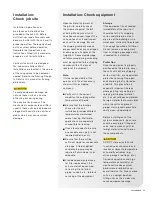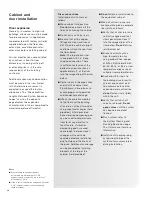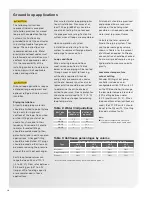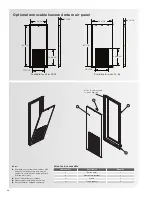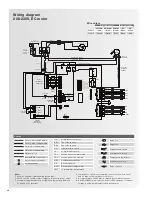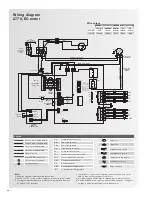
24
System cleaning
and flushing
Cleaning and flushing the unit
is the most important step to
ensure proper start-up and
continued efficient operation
of the system. Follow the
instructions to the right to
properly clean and flush the
system.
■
■
Verify that electrical power to
the unit is off.
■
■
Verify that supply and return
riser service valves are closed
at each unit.
■
■
Fill the system with water,
leaving the air vents open.
Bleed all air from the system
but do not allow the system to
over flow. Check the system for
leaks and make any required
repairs.
■
■
Adjust the water and air level in
the expansion tank.
■
■
With strainers in place, start
the pumps. Systematically
check each vent to ensure that
all of the air is bled from the
system.
■
■
Verify that make-up water
is available and adjusted to
properly replace any space
remaining when all air is
purged. Check the system for
leaks and make any additional
repairs if needed.
■
■
Set the boiler to raise the loop
temperature to approximately
85 °F (29 °C). Open the drain at
the lowest point in the system.
Verify that make-up water
replacement rate equals rate
of bleed. Continue to bleed the
system until the water appears
clean or for at least three hours
whichever is longer.
■
■
Completely drain the system.
Flush risers as follows:
■
■
Close shut-off valves at each
unit on the riser except the
shut-off valve on the top floor.
■
■
Flush solution through supply
riser.
Note:
The solution passes
through the top floor connection
down the return riser.
■
■
When the building has more
than ten floors, connect the
supply and return run outs on
the top two floors to divide
the water flow and reduce
pressure drop at the pump.
■
■
Repeat flushing procedure
for each set of risers in the
building.
■
■
Refill the system and add
in a proportion of trisodium
phosphate substitute
approximately one pound per
150 gallons (0.4 kg per 500
liters) of water. Reset the boiler
to raise the loop temperature
to about 100 °F (37.8 °C).
■
■
Circulate the solution for 8 to
24 hours. At the end of this
period, shut off the circulating
pump and drain the solution.
Repeat system cleaning if
needed.
■
■
Open the supply and return
riser service valves at each
unit. Refill the system and
bleed off all air.
■
■
Test the system pH with litmus
paper. The system water
should have a pH of 6 to 8.5.
Add chemicals, as appropriate,
to maintain pH levels.
■
■
When the cleaning process is
complete, remove the short-
circuited hoses. Reconnect the
hoses to the proper supply and
return the connections to each
of the units. Refill the system
and bleed off all air.
Note
■
■
Do not
use “Stop Leak” or similar chemical
agent in this system. Addition of chemicals
of this type to the loop water will foul the
heat exchanger and inhibit unit operation.


